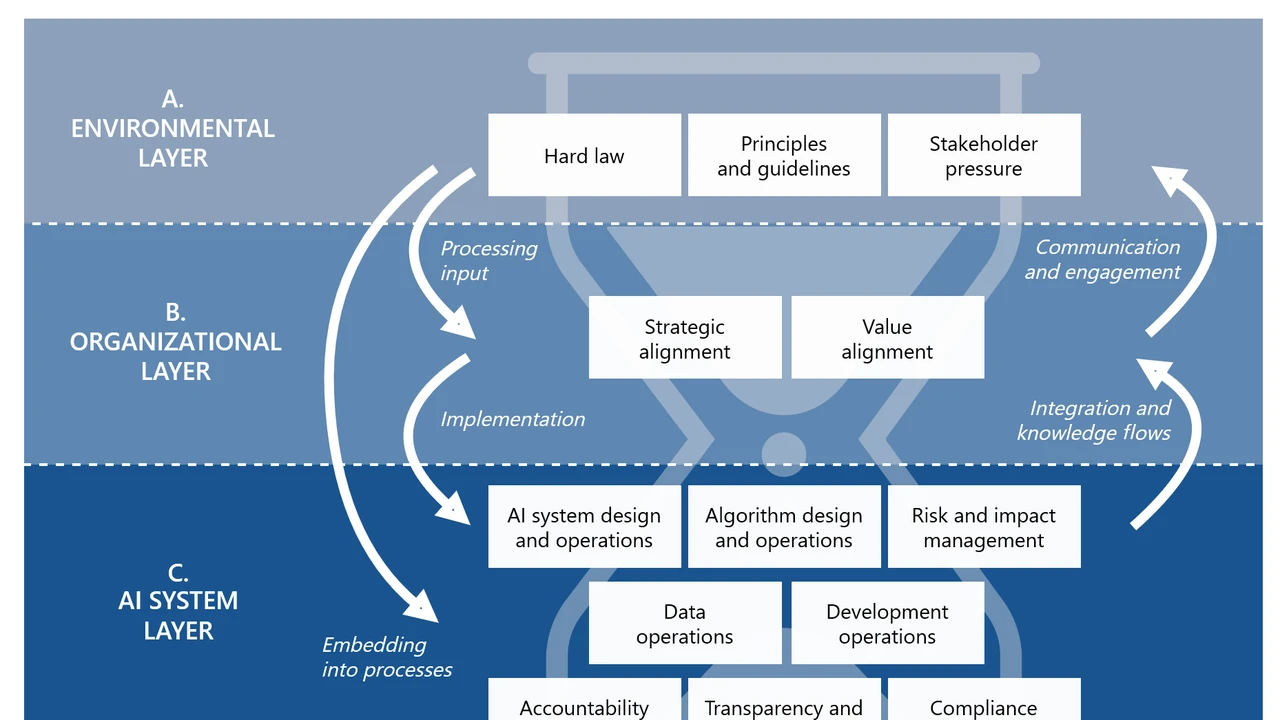AI and Governance: The Need for Regulation and Oversight

meta description: Follow the top AI experts and thought leaders by reading AI blogs. This article provides a list of recommended AI blogs. Stay informed about the latest trends and insights in AI.
Why Follow AI Blogs? Stay Updated on Artificial Intelligence Trends
In the rapidly evolving world of Artificial Intelligence (AI), staying informed is crucial. AI blogs are a fantastic resource for professionals, researchers, students, and anyone interested in understanding the latest trends, breakthroughs, and challenges. These blogs offer a wealth of information, from technical deep dives to insightful analyses of AI's societal impact. By following AI blogs, you can:
- Gain a deeper understanding of AI concepts: Many blogs explain complex AI topics in a clear and accessible way.
- Stay ahead of industry trends: Learn about new AI applications, technologies, and research findings.
- Discover practical applications of AI: See how AI is being used to solve real-world problems across various industries.
- Learn from experts: Get insights from leading AI researchers, engineers, and business professionals.
- Expand your network: Connect with other AI enthusiasts and professionals.
Top AI Blogs You Should Be Following: Expert Insights and Thought Leadership
Here's a curated list of some of the best AI blogs you should be following to stay informed and inspired:
1 OpenAI Blog: Discovering and Sharing AI Research
Focus: Research breakthroughs, AI safety, and the development of beneficial AI.
Why Follow: OpenAI is at the forefront of AI research. Their blog provides in-depth explanations of their latest projects, including GPT models, DALL-E, and other cutting-edge technologies. You'll find detailed research papers, code releases, and insightful discussions about the ethical implications of AI.
Example Content: Articles on the development of new AI models, discussions about AI safety and alignment, and updates on OpenAI's mission to ensure that AI benefits all of humanity.
Why it's great: The blog is written by the researchers and engineers who are actually building the AI, providing unparalleled access to their thought processes and findings.
2 DeepMind Blog: Exploring the Frontiers of Artificial Intelligence
Focus: AI research, machine learning, and the development of general-purpose AI.
Why Follow: DeepMind is another leading AI research organization, known for its groundbreaking work on AlphaGo, AlphaFold, and other AI systems that have achieved superhuman performance in various domains. Their blog covers a wide range of topics, from reinforcement learning to computer vision to natural language processing.
Example Content: Articles on the development of new reinforcement learning algorithms, research on protein folding using AI, and discussions about the potential of AI to solve some of the world's most pressing problems.
Why it's great: DeepMind's blog is highly technical, but it also includes more accessible articles that explain the broader implications of their research.
3 Google AI Blog: Google's Perspective on Artificial Intelligence
Focus: AI research, product development, and the application of AI to Google's various products and services.
Why Follow: Google is heavily invested in AI, and their blog provides a comprehensive overview of their AI initiatives. You'll find articles on a wide range of topics, from machine learning to computer vision to natural language processing, as well as updates on how AI is being used to improve Google Search, Google Assistant, and other Google products.
Example Content: Articles on the development of new AI-powered features for Google Search, research on natural language understanding, and discussions about the ethical considerations of AI.
Why it's great: Google's AI blog is a great resource for staying up-to-date on the latest AI developments at Google and in the broader AI community.
4 The Batch by Andrew Ng: AI Insights from a Leading Expert
Focus: News, analysis, and insights about the AI industry, with a focus on practical applications and business implications.
Why Follow: Andrew Ng is a renowned AI expert and co-founder of Coursera and Google Brain. His newsletter, "The Batch," provides a concise and insightful overview of the week's top AI news stories. It's a great way to stay informed about the latest developments in the AI industry without getting bogged down in technical details.
Example Content: Summaries of key AI news stories, interviews with AI experts, and analysis of the business implications of AI.
Why it's great: Andrew Ng's expertise and credibility make "The Batch" a trusted source of information for AI professionals.
5 Towards Data Science: A Community Platform for Data Scientists and AI Enthusiasts
Focus: Tutorials, articles, and discussions about data science, machine learning, and AI.
Why Follow: Towards Data Science is a community platform where data scientists and AI enthusiasts can share their knowledge and insights. You'll find a wide range of articles on topics such as machine learning algorithms, data visualization, and AI ethics. It's a great resource for learning new skills and connecting with other AI professionals.
Example Content: Tutorials on how to build machine learning models, articles on data visualization techniques, and discussions about the ethical implications of AI.
Why it's great: Towards Data Science is a great resource for both beginners and experienced data scientists and AI professionals.
6 Machine Learning Mastery: Practical Tutorials and Resources for Machine Learning
Focus: Practical tutorials and resources for learning machine learning.
Why Follow: Machine Learning Mastery provides hands-on tutorials and code examples that will help you learn how to build machine learning models. The blog covers a wide range of topics, from basic machine learning algorithms to advanced deep learning techniques. It's a great resource for anyone who wants to learn how to apply machine learning to real-world problems.
Example Content: Tutorials on how to build a neural network, articles on feature engineering, and code examples for various machine learning algorithms.
Why it's great: The tutorials are clear, concise, and easy to follow, making Machine Learning Mastery a great resource for beginners.
7 Fast AI Blog: Making Neural Nets Uncool Again
Focus: Democratizing AI education and making it accessible to everyone.
Why Follow: Fast AI is dedicated to making AI education more accessible. Their blog and courses emphasize practical applications and hands-on learning. They also advocate for responsible AI development and ethical considerations.
Example Content: Blog posts detailing practical applications of deep learning, discussions on ethical AI, and announcements of new courses and resources.
Why it's great: Fast AI's approach is refreshing and empowering. They focus on empowering individuals to build and use AI responsibly.
8 Analytics Vidhya: Comprehensive Resources for Data Science and AI
Focus: Data science and AI education, tutorials, and community discussions.
Why Follow: Analytics Vidhya offers a wide range of resources for learning data science and AI, including tutorials, articles, and practice problems. Their blog covers a variety of topics, from basic statistics to advanced machine learning techniques. It's a great resource for anyone who wants to improve their data science and AI skills.
Example Content: Tutorials on data cleaning, articles on different machine learning algorithms, and discussions about the latest trends in AI.
Why it's great: Analytics Vidhya provides a comprehensive learning experience, with resources for all skill levels.
9 AI Trends: Business and Technology Insights on Artificial Intelligence
Focus: Business and technology trends related to AI, including market analysis, industry news, and expert opinions.
Why Follow: AI Trends provides a high-level overview of the AI industry, covering topics such as market trends, investment activity, and the adoption of AI in various industries. It's a great resource for business professionals who want to understand the strategic implications of AI.
Example Content: Market research reports on the AI industry, articles on the business applications of AI, and interviews with AI executives.
Why it's great: AI Trends provides a valuable perspective on the business side of AI.
10 Lex Fridman Podcast: Conversations on Artificial Intelligence, Science, and Philosophy
Focus: Long-form conversations with leading AI researchers, scientists, and philosophers.
Why Follow: While not technically a blog, the Lex Fridman Podcast is an invaluable resource for anyone interested in AI. Lex Fridman conducts in-depth interviews with some of the most influential figures in the AI world, exploring topics such as the future of AI, the ethical implications of AI, and the philosophical underpinnings of intelligence.
Example Content: Interviews with Yoshua Bengio, Yann LeCun, and other leading AI researchers.
Why it's great: The long-form format allows for deep and nuanced conversations that provide valuable insights into the minds of the people who are shaping the future of AI.
AI Products to Enhance Your Workflow: Tools for Development and Experimentation
Following AI blogs keeps you informed, but sometimes you need practical tools to apply what you learn. Here are a few AI-powered products that can enhance your workflow, depending on your specific needs:
1 Amazon SageMaker: A Comprehensive Machine Learning Platform
Description: Amazon SageMaker is a fully managed machine learning platform that provides everything you need to build, train, and deploy machine learning models. It's a powerful tool for data scientists and machine learning engineers who want to streamline their workflow and accelerate their development process.
Use Case: Building and deploying machine learning models for various applications, such as fraud detection, customer churn prediction, and image recognition.
Comparison: SageMaker competes with other cloud-based machine learning platforms, such as Google Cloud AI Platform and Microsoft Azure Machine Learning. SageMaker is known for its scalability, flexibility, and comprehensive feature set.
Pricing: SageMaker offers a pay-as-you-go pricing model, with costs based on the resources you consume.
2 TensorFlow: An Open-Source Machine Learning Framework
Description: TensorFlow is a free and open-source machine learning framework developed by Google. It's a versatile tool that can be used to build a wide range of machine learning models, from simple linear regressions to complex deep learning networks.
Use Case: Building and training machine learning models for various applications, such as image classification, natural language processing, and time series forecasting.
Comparison: TensorFlow competes with other machine learning frameworks, such as PyTorch and Scikit-learn. TensorFlow is known for its scalability, performance, and large community support.
Pricing: TensorFlow is free to use, but you may need to pay for cloud resources (such as AWS EC2 or Google Cloud Compute Engine) to train and deploy your models.
3 Grammarly: AI-Powered Writing Assistant
Description: Grammarly is an AI-powered writing assistant that helps you improve your grammar, spelling, punctuation, and style. It's a useful tool for anyone who wants to write more clearly and effectively.
Use Case: Improving the quality of your writing, whether you're writing emails, reports, or blog posts.
Comparison: Grammarly competes with other writing assistants, such as ProWritingAid and Hemingway Editor. Grammarly is known for its accuracy, ease of use, and comprehensive feature set.
Pricing: Grammarly offers a free version with basic features, as well as a premium version with more advanced features. The premium version costs around $12 per month.
4 Otter AI: AI-Powered Transcription Service
Description: Otter AI is an AI-powered transcription service that automatically transcribes audio and video recordings. It's a valuable tool for journalists, researchers, and anyone who needs to create transcripts quickly and accurately.
Use Case: Transcribing interviews, lectures, and meetings.
Comparison: Otter AI competes with other transcription services, such as Trint and Descript. Otter AI is known for its accuracy, speed, and integration with popular conferencing platforms.
Pricing: Otter AI offers a free version with limited transcription minutes, as well as a premium version with unlimited transcription minutes. The premium version costs around $10 per month.
5 Jasper AI: AI-Powered Content Creation
Description: Jasper AI is an AI-powered content creation tool that helps you generate high-quality content for your website, blog, or social media channels. It uses natural language processing to understand your topic and generate original content that is both engaging and informative.
Use Case: Creating blog posts, social media updates, website copy, and other types of content.
Comparison: Jasper AI competes with other AI content creation tools, such as Copy.ai and Rytr. Jasper AI is known for its high-quality output, versatility, and ability to generate content in multiple languages.
Pricing: Jasper AI offers a variety of pricing plans, starting at around $29 per month. The cost will depend on the number of words you generate and the features you need.
Tips for Getting the Most Out of AI Blogs: Stay Engaged and Informed
To maximize the value you get from following AI blogs, consider these tips:
- Be selective: Focus on blogs that align with your specific interests and skill level.
- Read regularly: Set aside time each week to read new blog posts.
- Engage with the community: Leave comments, ask questions, and participate in discussions.
- Experiment with the tools and techniques you learn: Apply your knowledge to real-world problems.
- Stay curious: The field of AI is constantly evolving, so be open to learning new things.
Embrace Lifelong Learning in AI: The Future is Now
By following these top AI blogs and experimenting with AI-powered products, you can stay at the forefront of this exciting field and unlock new opportunities for innovation and growth. So, dive in, start exploring, and embrace the future of AI!
Ingredients
-
½ yellow onion, sliced
-
4 boneless pork chops
-
26 ounces condensed cream of mushroom soup
-
¼ cup water
-
2 cubes beef bouillon
Local Offers
Directions
-
Gather all ingredients. Preheat the oven to 325 degrees F (165 degrees C).
:max_bytes(150000):strip_icc()/277019-baked-pork-chops-with-cream-of-mushroom-soup-DDMFS-step-1-BG-7388-2a70dfddad2a4d5cb5678c8d1a24ed4a.jpg)
Dotdash Meredith Food Studios
-
Place onion slices on the bottom of a glass baking dish. Lay pork chops over onions. Cover chops evenly with condensed soup.
:max_bytes(150000):strip_icc()/277019-baked-pork-chops-with-cream-of-mushroom-soup-DDMFS-step-4-BG-7394-516b237660e64d928234c833f543fe56.jpg)
Dotdash Meredith Food Studios
-
Add water and bouillon, breaking up the bouillon cubes to spread flavor. Cover the baking dish with aluminum foil.
:max_bytes(150000):strip_icc()/277019-baked-pork-chops-with-cream-of-mushroom-soup-DDMFS-step-6-BG-7401-d826d25e46504d388da81bcc63c41a6a.jpg)
Dotdash Meredith Food Studios
-
Bake pork chops in the preheated oven, stirring gravy once or twice, until no longer pink in the center, about 1 hour. An instant-read thermometer inserted into the center of a chop should read at least 145 degrees F (63 degrees C).
:max_bytes(150000):strip_icc()/277019-baked-pork-chops-with-cream-of-mushroom-soup-DDMFS-step-7-BG-7469-f8451cf1469648c8bd47448131fc9dc3.jpg)
Dotdash Meredith Food Studios
Cook’s Note
You can use onion flakes if you don't have an onion on hand.
Nutrition Facts (per serving)
| 419 | Calories |
| 20g | Fat |
| 14g | Carbs |
| 44g | Protein |
:max_bytes(150000):strip_icc()/277019-baked-pork-chops-with-cream-of-mushroom-soup-DDMFS-beauty-4x3-BG-7505-5762b731cf30447d9cbbbbbf387beafa.jpg)






: Understanding Human Language.webp)